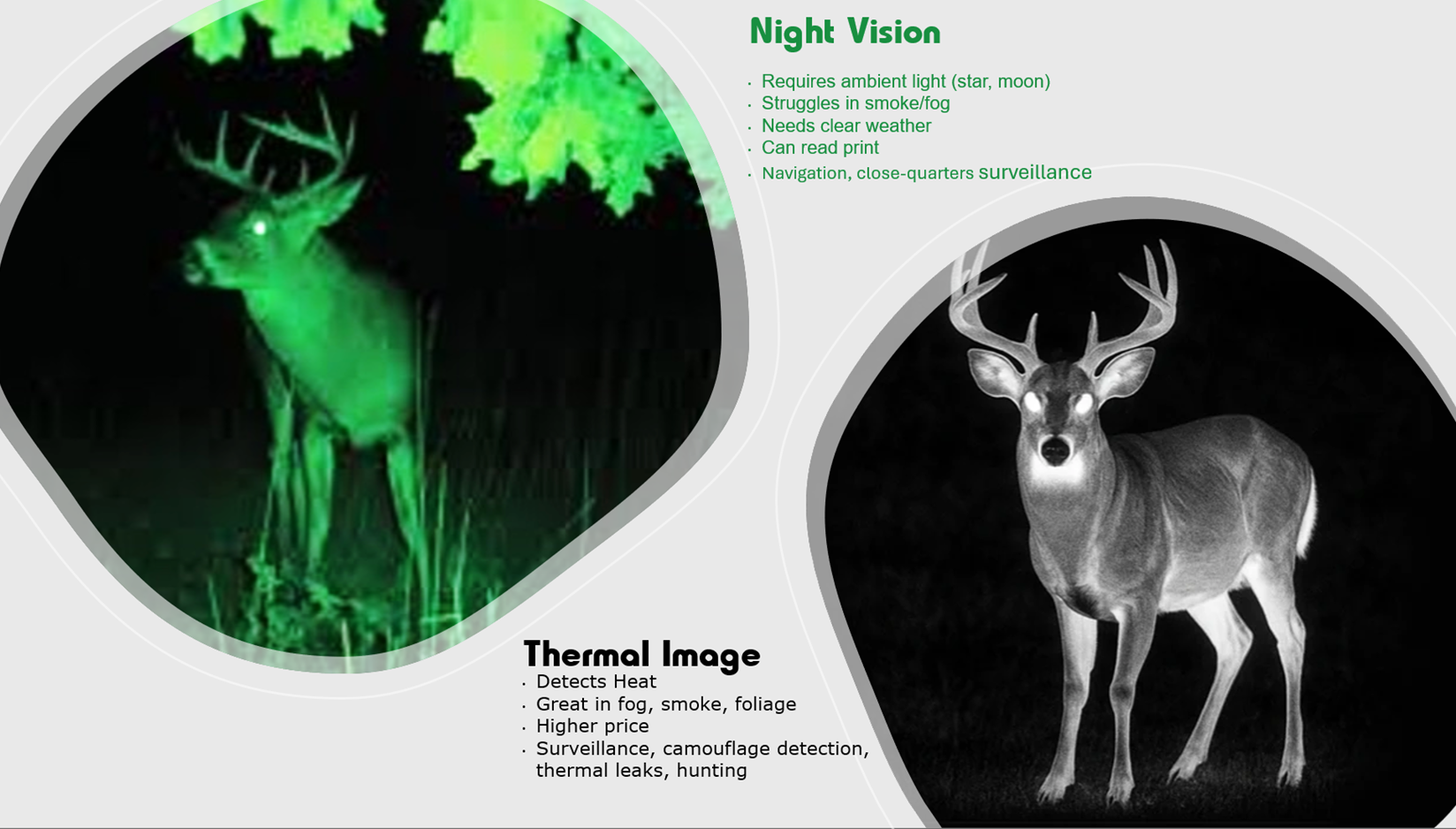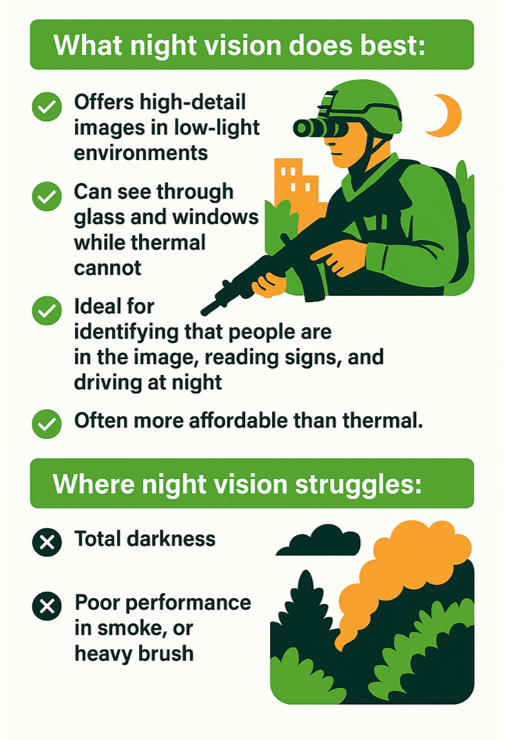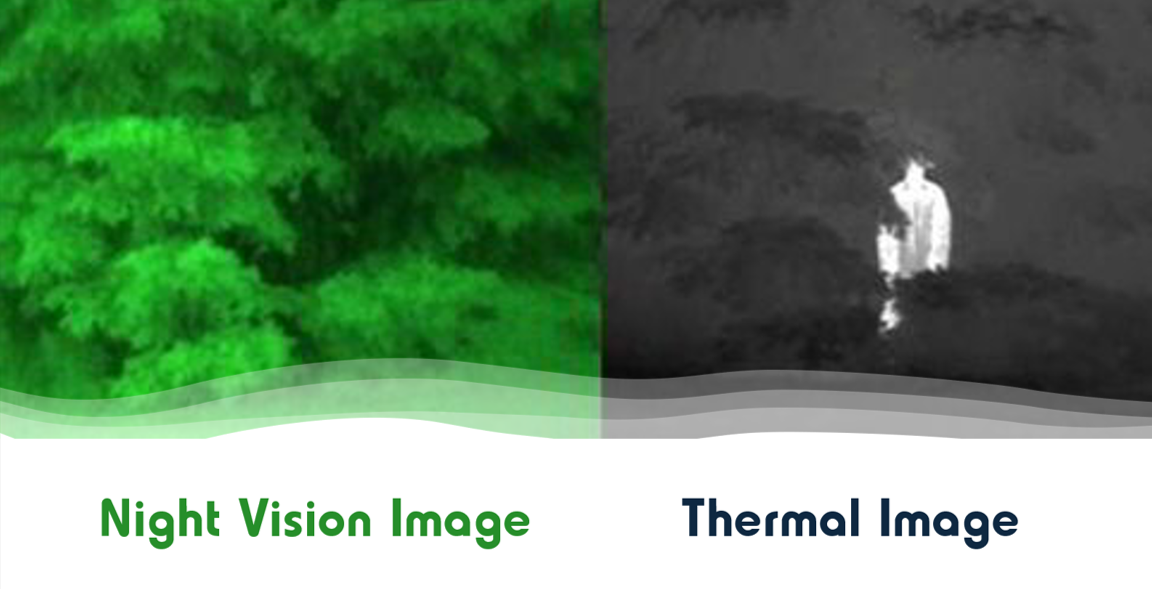Let’s face it—seeing in the dark is one of humanity’s oldest dreams. Whether you’re tracking heat signatures in dense forest, watching for movement across a quiet border, or just trying not to trip over your dog in a power outage, your optics matter. Both thermal vision and night vision technologies are designed to enhance visibility during night time, making them essential for activities in low light or complete darkness. But when it comes to thermal vision vs. night vision, the choice isn’t just about price tags or cool tech—it’s about understanding what each system sees, what it doesn’t, and which one works for your mission. This article will focus on the night vision vs thermal optics debate, helping you compare their advantages, limitations, and best use cases. We’ll break down the main differences between these two technologies so you can make an informed decision.

Know Your Tech: Thermal and Night Vision 101
At a glance, both thermal and night vision devices seem like magic—but they’re powered by very different science. Both systems rely on advanced technology and specialized sensors to create images in low-light or no-light conditions. Night vision technology and thermal technology differ significantly in their operating principles and applications.
Night vision amplifies existing light—moonlight, starlight, even a flickering campfire—to give you a green-tinged view of the world. Night vision requires some ambient light to function, as it cannot operate in complete darkness without a light source. The device collects all available light, including visible light from various light sources such as the moon, stars, or artificial illumination, and amplifies it to produce a clearer image. Think of it like cranking up the volume on a whisper—you get more detail, but only if there’s something to amplify.
Thermal imaging, on the other hand, doesn’t care about light. It detects infrared radiation—in other words, heat—and turns temperature differences into images. On thermal imaging screens, lighter colors typically represent hotter objects or areas. That’s why a thermal scope can “see” a person through hiding in brush or in pitch-black nights.
So yes, both work in the dark. But how they do it—and what they show you—is totally different.
How Thermal Imaging Works: Heat, Not Light
Thermal cameras are like the world’s most high-tech thermometers. They sense the heat every object emits and reflects and maps it visually. These thermal imaging devices detect body heat from living beings against cooler backgrounds and surroundings, making it easy to spot animals or people. Humans? Hot. Rocks? Cool. A truck engine that’s been off for an hour? Still warmer than the air around it. Thermal imaging can detect heat and even minute differences in temperature, which is especially useful for detecting living beings such as animals or people. While night vision scope (called I2 or image intensifiers) only see reflected light and don't work in complete darkness.

This tech isn’t just for sci-fi movies—it’s deployed in real-world military operations, search-and-rescue missions, and high-end hunting setups. Thermal devices and thermal imagers are used for detection and identification in various applications, providing significant advantages in challenging conditions. In hunting or surveillance, a thermal device can highlight a warm body, and a target is detected by its heat signature, even in total darkness or through visual barriers.
Thermal imagers use different color palettes to display heat signatures, enhancing the visibility of targets and providing an advantage in inclement weather where traditional night vision may struggle.
What thermal imager does best:
-
Works in complete darkness, foliage, smoke, and haze
-
Highlights living beings and recently moved equipment
-
Operates in all-weather conditions
-
Provides long range detection and can see through visual barriers such as foliage
What thermal doesn’t do well:
How Night Vision Works: Amplifying What’s There
Night vision devices take what little light is available, magnify it using image intensifier tubes, and display it in a way that the human eye can understand—usually with that iconic green glow. A night vision device, such as night vision goggles, is designed to amplify ambient light, making it possible to see in low-light conditions. Digital night vision scopes are not the same as night vision but use low light cameras and are typically less sensitive meaning they need moonlight or an illumination source, but they can be very inexpensive. Older models of night vision devices are often available at lower prices due to outdated technology, making them a budget-friendly option for those seeking affordability. A night vision scope is a popular choice for many users seeking reliable performance in the field when ambient light is lower.
But here’s the catch: if there’s no light, night vision doesn’t work. That’s why many scopes come with IR illuminators, which act like invisible flashlights to brighten the scene. Some night vision scopes require more light to produce detailed images, especially at close range.
What night vision does best:
-
Offers high-detail images in low-light environments
-
Can see throught glass and windows while thermal cannot
-
Ideal for identifying that people are in the image, reading signs, and driving at night
-
Often more affordable than thermal.
Where night vision struggles:

Night optics is a general category that includes night vision devices (NVDs) and thermal imagers, and the choice of device depends on the user’s needs. Image quality and the ability to produce clear images are crucial for identification, especially when compared to what is visible to the naked eye.
Thermal vs. Night Vision: A Showdown
The image below, provided by FLIR, is the perfect example of how a person can hide in foliage from night vision that would be quickly seen using thermal imaging.
When considering night vision vs thermal imaging, it's important to understand the difference between these two types of night optics. This comparison highlights the main differences in technology, design, and application, helping users choose the right device for their needs.

Let’s break it down:
|
Feature
|
Thermal Imaging
|
Night Vision
|
|
Primary Function
|
Detects heat (infrared radiation) using thermal technology
|
Amplifies visible/near-infrared light with night vision technology and sees through glass must have some illumination (starlight, moonlight)
|
|
Darkness
|
Works in total darkness; thermal scopes detect radiation emitted as heat
|
Needs some ambient light or illumination
|
|
Range of Hand Carried Scopes
|
Standard models can provide visibility of 100-250 meters, while specialized ones, like gen 3 devices or long-range binoculars, can reach up to 1000 meters.
|
Standard models can provide visibility of 100-250 meters, while specialized ones, like gen 3 devices or long-range binoculars, can reach up to 1000 meters
|
|
Detail Level
|
Lower resolutions are mostly good for silhouettes, while higher resolution, more expensive options can be used to see features; image quality depends on sensor resolution
|
High image clarity for classification (is this a deer or horse or a person); image quality varies by device and technology and resolution
|
|
Weather Tolerance
|
Great in smoke and haze due to thermal technology
|
Degraded by obscurants such as smoke, light fog, or foliage
|
|
Price Range
|
Generally higher, especially cooled systems
|
Lower-cost options available
|
|
Ideal Use
|
Surveillance, camouflage detection, thermal leaks, hunting
|
Navigation, close-quarters surveillance
|
The main differences between thermal imaging and night vision systems are found in their operating principles, the type of image each device produces, and their effectiveness in various conditions. Thermal imaging devices use infrared cameras and infrared sensors to detect heat radiation (both reflected and emitted), while night vision devices rely on amplifying available light. Both types of night optics have advanced technology, but their image quality and performance can vary significantly depending on the application and environment.
Applications: From Backwoods to Battlefield
Both technologies have carved out distinct niches in defense, law enforcement, and outdoor recreation. When choosing equipment, consider that night optics is a general category that includes both night vision and thermal imaging device options, each with unique advantages.
Thermal scopes are a hunter’s best friend—tracking game in dense forests or spotting coyotes from 300 yards away. These thermal devices are also widely used in border surveillance, industrial monitoring, and search and rescue operations, thanks to their ability to detect heat signatures in challenging conditions. These devices can range in cost from low end microbolometer based systems in the hundreds of dollars to high end cooled devices in the 10s of thousands of dollars.
Night vision scopes, meanwhile, are often the tool of choice for law enforcement, military patrols, and tactical drivers—anywhere detailed image interpretation matters more than heat. Many budget-friendly models utilize night vision technology or tubes, making them accessible for various applications, while high-end night vision can cost several thousand dollars for advanced models.
Pro tip: if you’re operating in an area with high humidity, thick brush, or zero ambient light, a thermal device might save your hide. If you’re trying to identify someone or read a license plate, go night vision. Depending on your scenario, both night vision technology and thermal device options offer distinct benefits for hunting, surveillance, and rescue.
Considerations for Surveillance
When it comes to surveillance, choosing between thermal imaging and night vision devices is all about matching your gear to your environment and mission. Each technology brings unique strengths to the table, and understanding these can make all the difference when you need to spot a target—whether it’s a prowler in the backyard or wildlife in the woods.
Thermal imaging devices—like thermal scopes—excel at detecting heat signatures, making them invaluable for picking out living beings through dense foliage, smoke, or even in total darkness. Because thermal scopes detect infrared radiation rather than relying on visible or ambient light, they’re largely unaffected by inclement weather conditions such as heavy rain or fog. This makes them a top choice for outdoor surveillance in unpredictable environments, where visual barriers and low light are the norm.
On the other hand, night vision devices—including night vision scopes and digital night vision scopes—amplify available light, whether it’s moonlight, starlight, or infrared light from an IR illuminator. While night vision technology can deliver clear images and help you identify faces or read license plates, it does require some existing light to function. In environments with little to no ambient light, or where weather conditions obscure visibility, night vision may struggle to keep up with thermal imaging.
Range is another key factor. Thermal scopes are particularly effective for long-range surveillance, as they can detect body heat and other heat signatures at significant distances—even when the human eye or traditional night vision would miss them. Night vision scopes, while excellent for close to mid-range observation, may lose image clarity at longer distances or in very low-light conditions.
The type of surveillance matters, too. If your goal is simply to detect movement or confirm the presence of living beings, thermal imaging is hard to beat. It can spot a person or animal hiding behind a bush or moving through the shadows, regardless of available light. If, however, you need to identify specific details—like distinguishing between a person and an animal, or reading a sign—night vision devices, with their ability to amplify and clarify visible light, may be the better option.
For those who want the best of both worlds, some advanced digital night vision scopes now offer hybrid capabilities, allowing users to switch between thermal imaging and night vision modes as needed. This flexibility can be a game-changer in dynamic surveillance environments, letting you adapt to changing light levels or weather conditions on the fly.
And don’t forget about IR illuminators—these handy add-ons can boost the performance of night vision devices in near-total darkness by providing an invisible light source that only your night vision device can see.
Bottom line: The right surveillance device depends on your specific needs, the environment you’re monitoring, and the level of detail you require. By weighing the advantages of thermal imaging and night vision technology—and considering hybrid solutions when appropriate—you’ll be better equipped to detect, identify, and respond to whatever moves in the night.
What Affects Performance?
Here’s where things get a little geeky—but stay with me. Performance depends on:
-
Sensor quality (thermal resolution or image intensifier grade)
-
Environmental conditions (fog, heavy rain, and other forms of inclement weather will impact night vision devices first; thermal imaging has an advantage and may perform in these conditions, giving it advantages over traditional night vision)
-
Optic range and clarity
-
User experience (are you viewing on a helmet? handheld? integrated into a UGV?)
Also, don’t forget battery life. Thermal scopes tend to consume more power, especially high-end cooled models. If you’re going off-grid, choose a system with efficient power management or bring backups.
Choosing the Right Optics: What’s Right for You?
There’s no universal winner—it all depends on your mission, environment, and personal preference.
Ask yourself:
-
Do I need to see heat, or do I need image clarity?
-
Will I be in total darkness or low-light conditions?
-
Is it more important to detect movement or identify faces?
And yes—if budget and weight allow, some of the most advanced systems (like the ones we build at Clear Align) offer multi-sensor fusion: visible, SWIR, MWIR, and LWIR all packed into one ruggedized platform. That’s the future we have yet to realize — one optic to rule them all (we might need some new material for this).
Final Thoughts: It’s Not a Competition—It’s a Choice
Night vision and thermal imaging aren’t rivals—they’re complementary tools. Knowing how they work, where they shine, and where they fall short makes you a smarter buyer, a better operator, and a safer teammate in the field.
So whether you're setting up perimeter surveillance, gearing up for a night hunt, or designing a next-gen UGV platform—choose wisely, and consider the real-world conditions you’re planning to face.
Because in the dark, the right optics don’t just help you see—they help you win.
Want help choosing between thermal and night vision for your mission?
Clear Align builds and integrates battle-proven imaging systems for real-world operations—from border towers to autonomous platforms. Reach out. We’ll help you see what others can’t.